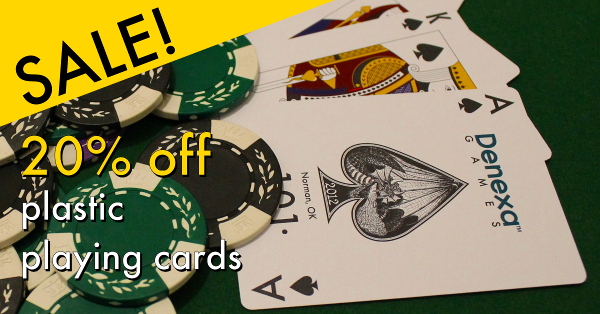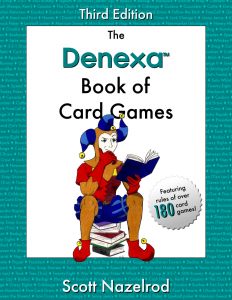Crates
Crates is a game in the Stops family that can be played by two to five players, with four players in partnerships being the usual arrangement. Like many games before and after it, Crates extends the basic game play of Crazy Eights, adding additional effects by various cards and an entire scoring system.
Crates was invented by a group of Chicago Contract Bridge players in 1970, who used it as a way to kill time waiting for Bridge sessions to start. It was spread throughout the United States by Bridge players traveling to tournaments in other states.
Object of Crates
The object of Crates is to have the lowest score at the end of fifteen hands. This is achieved by discarding as many cards as possible from your hand.
Setup
To play Crates, you’ll need a standard 52-card deck of playing cards. We don’t think it’s too crazy to recommend using Denexa 100% Plastic Playing Cards. You’ll also need something to keep score with. The traditional pencil-and-paper combo works well, as does one of the many smartphone applications developed for the purpose of keeping score.
If you’re playing the four-player partnership game, determine your partners first, either by mutual agreement or by some random method. Each player should sit across from their partner, with their opponents at their left and right. In partnership games, the partners share a score, but otherwise, play is governed by the same rules as non-partnership games.
As in Oh Hell!, the starting hand size varies from hand to hand. The first hand is dealt with eight cards, the second with seven, and so on until a one-card hand has been played. Thereafter, the hand sizes start increasing again, by one card each hand, until the fifteenth and final hand, which is again played with eight cards.
Shuffle and deal the appropriate number of cards. Place the stub in the center of the table, forming the stock. Turn the top card of the stock face up; this card, the upcard, will be the top card of the discard pile. If the upcard is an 8 or a 9, the dealer must name a suit for the first play of the game before looking at their cards. If it is a 9, the suit named must be the same color as that of the 9.
Game play
The player to the dealer’s left plays first. They play one card from their hand of the same suit or rank as the upcard. If a player is unable to play, they draw one card from the stock, ending their turn. Play then passes to the next player in turn.
If a player is unable to draw when required to because the stock has been exhausted, they receive a pressure. A player’s first pressure of the game is worth five points. Each subsequent pressure in a game scores double the previous one; a player’s second pressure (even if on a later hand) is worth ten points. The third is then worth 20 points, the fourth 40, etc. (In partnership games, the two partners’ pressures are counted together.) Pressures are scored immediately as they happen. After scoring for a pressure, that player then turns the discard pile face down and shuffles it to form a new stock. They then draw from the replenished stock as usual, and their turn ends.
Special card effects
Many cards in Crates have special effects when played. The “typical” cards which do not have any immediate effect on game play when played are aces, 3s, queens, and kings.
2-sequences
When a 2 is played, it starts a run of cards called a 2-sequence. Normal play is suspended until the 2-sequence is resolved. The next player in turn from the player who played a 2 must play either another 2 or an ace. If they can, the next player in turn after them must do the same, and so on. This continues until a player is unable to play either of these cards. That player adds up the total pip value of all of the cards played in the sequence and draws that many cards from the stock. The next player in turn after the person who drew cards plays as usual off the last card of the 2-sequence.
4s
When a 4 is played, the next player’s turn is skipped.
5s
When a 5 is played, each player in turn draws a card, ending with the player before the one who played the 5. (The person who played the 5 does not have to draw a card.) It is important that each player draw in turn, in case a pressure occurs while resolving the 5.
6s
When a 6 is played, the person playing it must play a second card before their turn ends. If they are unable to play another 6 or card of the same suit, they must draw a card, as per usual.
Should a player be stuck with a 6 as their last card, they cannot actually go out, because the 6 would require them to play a second card, which they do not have, so they must draw. Such a situation is called a Cooper.
7s
In the two- and three-player games, the next player in turn draws a card. In bigger games, the player after the next one draws a card. (It’s your partner that draws the card in the four-player partnership version. Convention is to sarcastically thank your partner for the card when they play a 7.) In all cases, this does not count as a turn; they play as normal after drawing.
8s and 9s
Both 8s and 9s allow the player to call a new suit. The following player is required to play a card of that suit, or switch suits with another card of the same rank. The suit called when playing a 9 must be the same color as that 9. There is no such restriction when playing an 8.
10s
The order of play reverses when a 10 is played. That is, if play had been proceeding to the left, it now goes around to the right, and vice-versa. In a two-player game, of course, 10s have no unusual effect.
Jacks
In a two-player game, a jack acts the same as a 7—the other player draws a card. In a three-player game, the player before the person playing the card draws one card. Jacks have no effect in games of four or more players.
Ending the hand
When a player holds two cards, they must say “One card” upon playing one of them. (The player is jeered by their opponents if they say “Uno” instead.) If they fail to do so, they must start their next turn by drawing two cards. (Note that this means that if another player goes out before their next turn, the penalty is never actually assessed.)
The hand ends when a player ends their turn with no cards. The only exception to this is if a 2-sequence is in progress when this happens. In that case, the hand ends when the 2-sequence is resolved first. (This means it’s possible for a player to run out of cards, watch the 2-sequence to go around back to them, and be forced to draw because they have no cards. The hand still ends then, meaning nobody ends with no cards.)
Scoring
Players score for the hand based on the values of cards left in their hand. Cards score as follows:
- Aces: 1 point
- 2s: 20 points
- 4s: 15 points
- 5s and 6s: 30 points each
- 7s: 20 points
- 8s: 50 points
- 9s: 30 points
- 10s: 25 points
- Face cards: 10 points each
Scoring for 3s is a little more complicated. A hand with only 3s in it scores –50 points per 3 held. If there are other ranks in the hand, each 3 “covers” one of the other cards. Each card covered by a 3 scores only three points. The only cards that cannot be covered in this way are 8s.
Game play continues until fifteen hands have been played. Whichever player or partnership has the lowest score at that point wins the game.
See also


